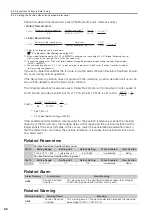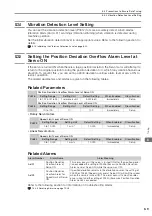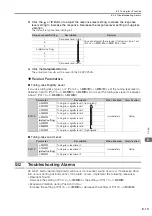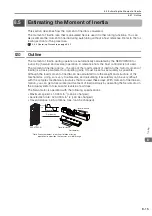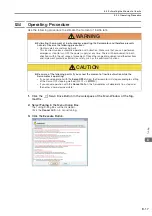
8.1 Overview and Flow of Tuning
8.1.1 Tuning Functions
8-5
8
T
uning
8.1.1
Tuning Functions
The following table provides an overview of the tuning functions.
8.1.2
Diagnostic Tool
You can use the following tools to measure the frequency characteristics of the machine and
set notch filters.
Tuning Function
Outline
Reference
Tuning-less Function
This automatic adjustment function is designed to enable stable opera-
tion without servo tuning. This function can be used to obtain a stable
response regardless of the type of machine or changes in the load. You
can use it with the default settings.
Moment of Inertia
Estimation
The moment of inertia ratio is calculated by operating the Servomotor a
few times.
The moment of inertia ratio that is calculated here is used in other tun-
ing functions.
Autotuning without
Host Reference
The following parameters are automatically adjusted in the internal ref-
erences in the SERVOPACK during automatic operation.
•
Gains (e.g., position loop gain and speed loop gain)
•
Filters (torque reference filter and notch filters)
•
Friction compensation
•
Anti-resonance control
•
Vibration suppression
Autotuning with Host
Reference
The following parameters are automatically adjusted with the position
reference input from the host controller while the machine is in opera-
tion. You can use this function for fine-tuning after you perform autotun-
ing without a host reference.
•
Gains (e.g., position loop gain and speed loop gain)
•
Filters (torque reference filter and notch filters)
•
Friction compensation
•
Anti-resonance control
•
Vibration suppression
Custom Tuning
The following parameters are adjusted with the position reference or
speed reference input from the host controller while the machine is in
operation.
•
Gains (e.g., position loop gain and speed loop gain)
•
Filters (torque reference filter and notch filters)
•
Friction compensation
•
Anti-resonance control
Anti-resonance
Control Adjustment
This function effectively suppresses continuous vibration.
Vibration
Suppression
This function effectively suppresses residual vibration if it occurs when
positioning.
Speed Ripple Com-
pensation
This function reduces the ripple in the motor speed.
Additional
Adjustment Function
This function combines autotuning with custom tuning. You can use it
to improve adjustment results.
Manual Tuning
You can manually adjust the servo gains to adjust the response.
Diagnostic Tool
Outline
Reference
Mechanical Analysis
The machine is subjected to vibration to detect resonance frequencies.
The measurement results are displayed as waveforms or numeric data.
Easy FFT
The machine is subjected to vibration to detect resonance frequencies.
The measurement results are displayed only as numeric data.


















